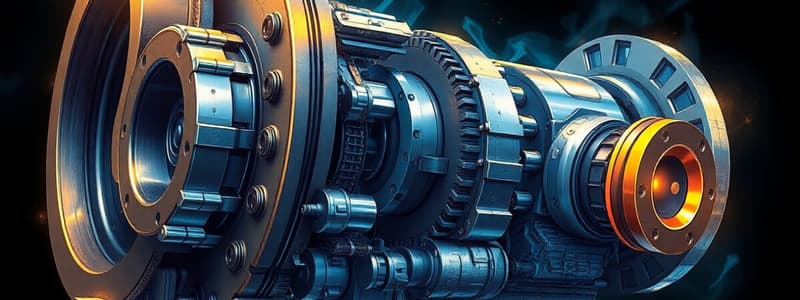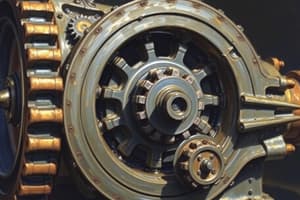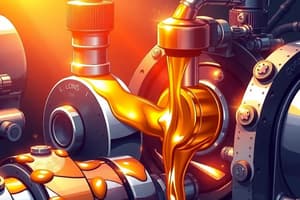Podcast
Questions and Answers
What is the relationship between the torque of gear B and gear A?
What is the relationship between the torque of gear B and gear A?
- TB = TA
- TB = 2 TA (correct)
- TB = 0.5 TA
- TB = 3 TA
What is a key characteristic of a sliding mesh type gear box?
What is a key characteristic of a sliding mesh type gear box?
- It provides the highest transmission efficiency. (correct)
- It can engage multiple pairs of gears simultaneously.
- It requires expensive materials for construction.
- All gears are permanently fixed.
What must be done before shifting gears in a sliding mesh type gearbox?
What must be done before shifting gears in a sliding mesh type gearbox?
- Change the gear oil.
- Increase engine speed.
- Stop the tractor. (correct)
- Engage the parking brake.
In a system of gear rotation, how does the additional gear affect the rotation direction?
In a system of gear rotation, how does the additional gear affect the rotation direction?
What is NOT a limitation of sliding mesh type gearboxes?
What is NOT a limitation of sliding mesh type gearboxes?
Which of the following gear types is commonly used in indigenous tractors?
Which of the following gear types is commonly used in indigenous tractors?
Which shafts in a sliding mesh gearbox are usually parallel to each other?
Which shafts in a sliding mesh gearbox are usually parallel to each other?
What mechanism is used to ensure only one pair of gears engages at a time?
What mechanism is used to ensure only one pair of gears engages at a time?
What is the primary function of the gearbox in a tractor?
What is the primary function of the gearbox in a tractor?
The horsepower delivered to the rear wheels is directly affected by which of the following?
The horsepower delivered to the rear wheels is directly affected by which of the following?
If gear A has 10 teeth and is rotating at 100 rpm, what will be the speed of gear B with 20 teeth?
If gear A has 10 teeth and is rotating at 100 rpm, what will be the speed of gear B with 20 teeth?
How does increasing the torque at the wheels affect the speed required?
How does increasing the torque at the wheels affect the speed required?
What will happen if a tractor's engine power is delivered directly to the rear wheels?
What will happen if a tractor's engine power is delivered directly to the rear wheels?
What principle does gearing utilize to transmit motion between shafts?
What principle does gearing utilize to transmit motion between shafts?
What is the mathematical representation of horsepower delivered to the rear wheels?
What is the mathematical representation of horsepower delivered to the rear wheels?
What is the result of doubling the number of teeth on the driven gear?
What is the result of doubling the number of teeth on the driven gear?
What is a primary feature of the constant mesh transmission?
What is a primary feature of the constant mesh transmission?
What is necessary for shifting gears in a constant mesh transmission to prevent damage?
What is necessary for shifting gears in a constant mesh transmission to prevent damage?
Which component in a synchromesh transmission helps to equalize gear speeds before engagement?
Which component in a synchromesh transmission helps to equalize gear speeds before engagement?
What is a disadvantage of the synchromesh gear box compared to sliding mesh gear boxes?
What is a disadvantage of the synchromesh gear box compared to sliding mesh gear boxes?
What advantage does the constant mesh transmission have over sliding mesh type gear box regarding gear engagement?
What advantage does the constant mesh transmission have over sliding mesh type gear box regarding gear engagement?
Why is the synchromesh transmission rarely used in tractors?
Why is the synchromesh transmission rarely used in tractors?
How do helical gears benefit the operation of constant mesh transmissions?
How do helical gears benefit the operation of constant mesh transmissions?
Which statement correctly describes an operational characteristic of synchromesh transmissions?
Which statement correctly describes an operational characteristic of synchromesh transmissions?
Flashcards are hidden until you start studying
Study Notes
Horsepower & Torque
- Horsepower delivered to rear wheels is dependent on torque and engine speed.
- Higher torque requires lower engine speeds, and vice versa, for constant engine horsepower.
Necessity of Gearbox
- Tractive effort needed for rear wheels varies depending on load and ground conditions.
- Direct engine power delivery results in constant, high speeds and fixed tractive effort—not ideal for tractors.
- Tractors require high torque at low engine speed, while engines operate at high speed and low torque.
- Gearboxes are used to reduce engine speed, leading to torque multiplication for desired tractive effort.
Principle of gearing
- A gear train transmits motion between shafts via gear wheels.
- If a driving gear (A) has 10 teeth and a driven gear (B) has 20 teeth, and gear A rotates at 100 RPM, gear B's speed is calculated as:
- Speed of driven gear = (Speed of driving gear * Number of teeth on driven gear) / Number of teeth on driving gear
- Speed of driven gear = (100 RPM * 10 teeth) / 20 teeth = 50 RPM
- This shows that doubling the teeth on the driven gear halves the speed, but doubles the torque.
- The direction of rotation of the driven gear is opposite to the driving gear.
- In a compound gear train, the final gear rotates in the same direction as the driving gear.
- The final driven gear's speed depends on the product of gear ratios of each pair.
Types of Gearboxes:
- Sliding Mesh Gearbox: Most common in indigenous tractors.
- Main and counter shafts are parallel to the clutch shaft, with a third shaft for reverse gear.
- Gears on the counter shaft are fixed, while those on the main shaft slide to engage with appropriate counter shaft gears.
- Gearshift rails and forks are used for gear changes.
- Detent balls or other devices ensure only one gear pair engages at a time.
- Provides 3-4 forward speeds and 1 reverse speed.
- Advantages:
- High transmission efficiency
- Simple design
- Cost-effective
- Limitations:
- Suitable for small tractors only
- Hard to move large gears
- Large teeth can interfere and cause damage while shifting
- Tractor must be stopped before shifting to avoid damage.
- Constant Mesh Gearbox: Similar to sliding mesh, but the gears on the main and counter shaft are always in mesh.
- Gears on the main shaft are mounted on bushings, allowing them to rotate freely with the counter shaft gear in neutral.
- Spline sleeve couplings, controlled by the gear lever, engage or disengage gears.
- Coupling device movement locks a free gear onto the main shaft, getting drive through the driven gear.
- Slightly less efficient than the sliding mesh due to friction between rotating parts.
- The tractor needs to be stopped before shifting to avoid damage.
- Advantages:
- Constant gear mesh reduces wear and tear and damage during gear changes
- Helical gears minimize shifting noise and effort.
- Limitations:
- Tractor must be stopped before shifting to avoid damage.
- Synchromesh Gearbox: Basically a constant mesh with an added synchronizer device to equalize speeds before engagement.
- Common in automobiles, rare in tractors.
- Allows for shifting while the tractor is moving.
- Synchronizer regulates speed of gears and shafts before changing gears.
- Small cone-type clutches are used for synchronization.
- Advantages:
- Shifting without damage, even while the tractor is moving
- Popular for tractors used for highway transport
- Disadvantages:
- Lower power transmission efficiency compared to sliding mesh
- Higher cost
Studying That Suits You
Use AI to generate personalized quizzes and flashcards to suit your learning preferences.




